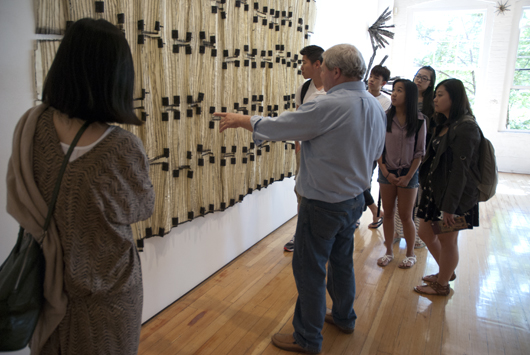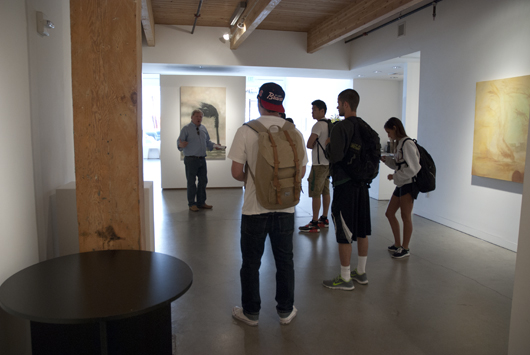Learning to Look: Visual Literacy
~A Photo Essay~
Summary: A Group of Urban Ducks Tour Portland’s Oldtown | Chinatown Galleries and Explore Public Art as Part of the Arts and Administration Program’s Arts and Visual Literacy. Urban Ducks are newly accepted and admitted University of Oregon students who have the opportunity to take courses at the White Stag Block.
Students in David Bretz’s Arts and Administration Program course, Art and Visual Literacy came to the University of Oregon in Portland’s White Stag location on July 12 for a special tour of art galleries and public art in the region. The course is geared to encourage
Students [to] explore the interactions of the physical, perceptual, affective, and cognitive modes of learning elements of experience, and how [these elements] come together in creating interpretations and forming judgments about the visual world.
The course is part of the UO Urban Ducks program, the Summer in the City courses, and the School of Architecture and Allied Arts, in addition to being offered by the Arts and Administration program.
The Friday, July 12 convergence began with a lecture by Bretz to introduce the students to the importance of noticing and observing their environment, to “start seeing and looking more and more at [their] personal environment and to recognize the culture of another.” [Instructor David Bretz]. Bretz continued, emphasizing that “artists are always coming up with new ideas and ways of expressing ideas” —letting us, as the audience, know “we are not alone in our (or their) feelings.” We, as the observers of culture and art, noted Bretz, are being “[pushed] as an audience to see more than what we would normally see” by art, architectural decoration | embellishment and design.
After the tour, I asked the instructor to comment on the course thus far and to summarize his reflections not only regarding the objectives of the course but also in relation to his students. What follows is instructor Bretz’s response:
Art and Visual Literacy is a course that is designed to assist individuals in becoming more conscious of and more adept at using visualization as part of their intuitive intelligences. This course draws upon the cultural matrix of ideas and practices associated with the arts to develop a broader understanding of the visual world and our interactions with the innumerable things we see. In addition, students are introduced to a set of conceptual skills for actively shaping and creating meanings in their visual culture.
The objective of the tour was to have students experience looking at a variety of visual phenomena within a specific cultural environment of China Town and the Pearl District in downtown Portland. I thought the students were attentive and interactive with the various visual images we observed. I thought it particularly interesting to observe the students looking at and using the terms of the elements and principles of design in their descriptions and discussions of various architectural details on buildings in this area of Portland. In addition to looking at signage, wall murals, sculpture and landscaping in this urban center, the students visited three art galleries, Butters Gallery LTD, Augen Gallery, and Froelick Gallery.
I have a culturally diverse class with European Americans, Vietnamese, Chinese, and Korean students. An objective was to have students look at a variety of objects and art within a specific area noting the culturally influenced architecture, sculpture and landscape decorations and to analyze and make meaning from what they perceive. I remember discussing an image under a street-side sculpture, where there was a carved granite stone with an image of a fish and an abacus. I asked the students to identify what these images were. There was no problem with the image of the fish, but only the Asian students knew about the image of the abacus. They called it a “calculator”…
I noticed that the students were beginning to use their descriptive and interpretational skills when they viewed the art in the three galleries we visited. It is very gratifying to observe students using newly discovered skills when viewing art. I believe the students were engaged in viewing the variety of visual art and objects, asking questions and contributing to discussions during the tour. I believe their willingness to explore art and culture and to express opinions and personal perspectives in this regard is commendable.
Images from July 12, 2013.
































